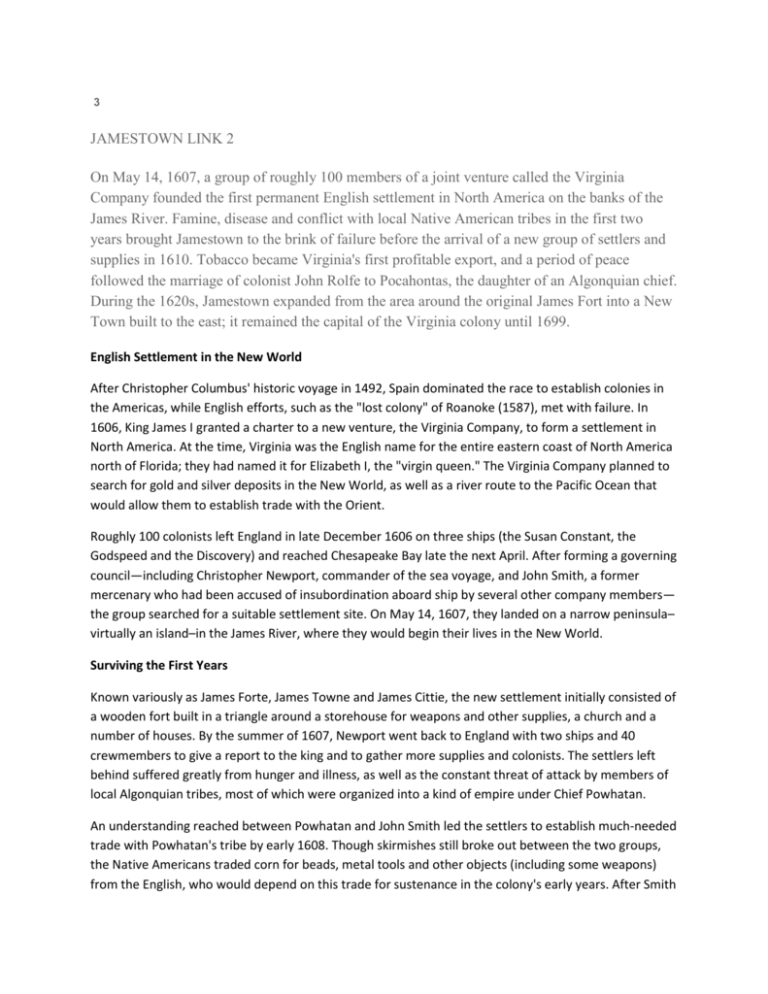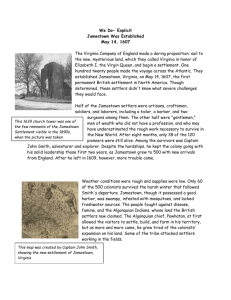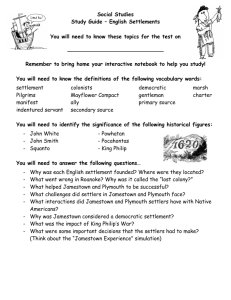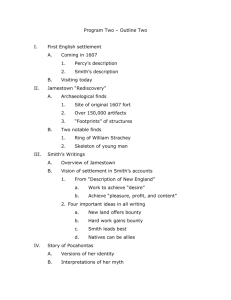3 JAMESTOWN LINK 2 On May 14, 1607, a group of roughly 100
advertisement

3 JAMESTOWN LINK 2 On May 14, 1607, a group of roughly 100 members of a joint venture called the Virginia Company founded the first permanent English settlement in North America on the banks of the James River. Famine, disease and conflict with local Native American tribes in the first two years brought Jamestown to the brink of failure before the arrival of a new group of settlers and supplies in 1610. Tobacco became Virginia's first profitable export, and a period of peace followed the marriage of colonist John Rolfe to Pocahontas, the daughter of an Algonquian chief. During the 1620s, Jamestown expanded from the area around the original James Fort into a New Town built to the east; it remained the capital of the Virginia colony until 1699. English Settlement in the New World After Christopher Columbus' historic voyage in 1492, Spain dominated the race to establish colonies in the Americas, while English efforts, such as the "lost colony" of Roanoke (1587), met with failure. In 1606, King James I granted a charter to a new venture, the Virginia Company, to form a settlement in North America. At the time, Virginia was the English name for the entire eastern coast of North America north of Florida; they had named it for Elizabeth I, the "virgin queen." The Virginia Company planned to search for gold and silver deposits in the New World, as well as a river route to the Pacific Ocean that would allow them to establish trade with the Orient. Roughly 100 colonists left England in late December 1606 on three ships (the Susan Constant, the Godspeed and the Discovery) and reached Chesapeake Bay late the next April. After forming a governing council—including Christopher Newport, commander of the sea voyage, and John Smith, a former mercenary who had been accused of insubordination aboard ship by several other company members— the group searched for a suitable settlement site. On May 14, 1607, they landed on a narrow peninsula– virtually an island–in the James River, where they would begin their lives in the New World. Surviving the First Years Known variously as James Forte, James Towne and James Cittie, the new settlement initially consisted of a wooden fort built in a triangle around a storehouse for weapons and other supplies, a church and a number of houses. By the summer of 1607, Newport went back to England with two ships and 40 crewmembers to give a report to the king and to gather more supplies and colonists. The settlers left behind suffered greatly from hunger and illness, as well as the constant threat of attack by members of local Algonquian tribes, most of which were organized into a kind of empire under Chief Powhatan. An understanding reached between Powhatan and John Smith led the settlers to establish much-needed trade with Powhatan's tribe by early 1608. Though skirmishes still broke out between the two groups, the Native Americans traded corn for beads, metal tools and other objects (including some weapons) from the English, who would depend on this trade for sustenance in the colony's early years. After Smith returned to England in late 1609, the inhabitants of Jamestown suffered through a long, harsh winter, during which more than 100 of them died. In the spring of 1610, just as the remaining colonists were set to abandon Jamestown, two ships arrived bearing at least 150 new settlers, a cache of supplies and the new English governor of the colony, Lord De La Warr. Growth of the Colony Though De La Warr soon took ill and went home, his successor Sir Thomas Gates and Gates' second-in command, Sir Thomas Dale, took firm charge of the colony and issued a system of new laws that, among other things, strictly controlled the interactions between settlers and Algonquians. They took a hard line with Powhatan and launched raids against Algonquian villages, killing residents and burning houses and crops. The English began to build other forts and settlements up and down the James River, and by the fall of 1611 had managed to harvest a decent crop of corn themselves. They had also learned other valuable techniques from the Algonquians, including how to insulate their dwellings against the weather using tree bark, and expanded Jamestown into a New Town to the east of the original fort. A period of relative peace followed the marriage in April 1614 of the colonist and tobacco planter John Rolfe to Pocahontas, a daughter of Chief Powhatan who had been captured by the settlers and converted to Christianity. (According to John Smith, Pocahontas had rescued him from death in 1607, when she was just a young girl and he was her father's captive.) Thanks largely to Rolfe's introduction of a new type of tobacco grown from seeds from the West Indies, Jamestown's economy began to thrive. In 1619, the colony established a General Assembly with members elected by Virginia's male landowners; it would become a model for representative governments in later colonies. That same year, the first Africans (around 50 men, women and children) arrived in the English settlement; they had been on a Portuguese slave ship captured in the West Indies and brought to the Jamestown region. They worked as indentured servants at first (the race-based slavery system developed in North America in the 1680s) and were most likely put to work picking tobacco. Later Years Pocahontas' death during a trip to England in 1617 and the death of Powhatan in 1618 strained the already fragile peace between the English settlers and the Native Americans. Under Powhatan's successor, Opechankeno, the Algonquians became more and more angry about the colonists' insatiable need for land and the pace of English settlement; meanwhile, diseases brought from the Old World decimated the Native American population. In March 1622, the Powhatan made a major assault on English settlements in Virginia, killing some 350 to 400 residents (a full one-quarter of the population). The attack hit the outposts of Jamestown the hardest, while the town itself received advance warning and was able to mount a defense. In an effort to take greater control of the situation, King James I dissolved the Virginia Company and made Virginia into an official crown colony, with Jamestown as its capital, in 1624. The New Town area of Jamestown continued to grow, and the original fort seems to have disappeared after the 1620s. Though the Powhatan people continued to mount a resistance (Opechankeno, by then in his 80s, led another great rebellion in 1644), the colony continued to grow stronger, and his successor Necotowance was forced to sign a peace treaty that ceded most of the Powhatans' land and forced them to pay an annual tribute to the colonial governor. In 1698, the central statehouse in Jamestown burned down, and Williamsburg replaced it as the colonial capital the following year.






